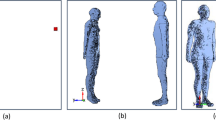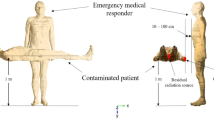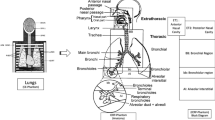Abstract
In this study, we estimated the ambient dose equivalent rate (hereafter “dose rate”) in the fluoro-2-deoxy-d-glucose (FDG) administration room in our hospital using Monte Carlo simulations, and examined the appropriate medical-personnel locations and a shielding method to reduce the dose rate during FDG injection using a lead glass shield. The line source was assumed to be the FDG feed tube and the patient a cube source. The dose rate distribution was calculated with a composite source that combines the line and cube sources. The dose rate distribution was also calculated when a lead glass shield was placed in the rear section of the lead-acrylic shield. The dose rate behind the automatic administration device decreased by 87 % with respect to that behind the lead-acrylic shield. Upon positioning a 2.8-cm-thick lead glass shield, the dose rate behind the lead-acrylic shield decreased by 67 %.






Similar content being viewed by others
References
Osodo K, Oomori K, Ito Y, Shibata H, Murakami K, Takahashi K. Distribution of radiation dose-rates in hot lab of PET center and ways of reducing radiation exposure for persons working there. JSPHCS. 2007;33:23–9.
Kashiwazaki R, Tochigi S, Onuki M, Suzuki K, Sakamoto S. Measurement of exposure dose and its reduction design for nurses in charge in FDG-PET/CT with contrast reviewing the manual and staff flow line. Radioisotopes. 2013;62:827–32.
Mochiduki Y, Uno K, Kosaka N, Watanabe H, Hoteida M, Sakaguchi K, et al. Measures to reduce occupational radiation exposure in clinical PET: a study at Nishidai Clinic Diagnostic Imaging Center. Radioisotopes. 2006;55:79–87.
Roberts FO, Gunawardana DH, Pathmaraj K, Wallace A, Mi T, et al. Radiation dose to PET technologists and strategies to lower occupational exposure. J Nucl Med Technol. 2005;33:44–7.
Guillet B, Quentin P, Waultier S, Bourrelly M, Pisano P, Mundler O. Technologist radiation exposure in routine clinical practice with 18F-FDG PET. J Nucl Med Technol. 2005;33:175–9.
Fukuda A, Koshida K, Yamaguchi I, Takahashi M, Kitabayashi K, Matsubara K, et al. Shielding effect of clinical X-ray protector and lead glass against annihilation radiation and gamma rays of 99 m Tc. Nippon Hoshasen Gijutsu Gakkai zasshi. 2004;60:1723–9.
Fujibuchi T, Iimori T, Masuda Y, Uchida Y, Isobe T, Sakae T. Evaluation of a real-time semiconductor dosimeter and measurement of finger dose in nuclear medicine departments. Radiol Phys Technol. 2010;3:54–7.
Fujibuchi T, Iimori T, Isobe T, Masuda Y, Uchida Y, Matsubayashi F. Measurement of absorbed doses in organs of medical staff at 18F-FDG pet examination. Radiol Phys Technol. 2010;3:34–9.
Sato H, Mori K, Fujisaku K, Yoneda H. Development of EGS5 Monte Carlo toolkit for estimation of dose distribution in X-ray diagnostic room. Jpn J Med Phys. 2010;30:25–38.
Alzimami K S, Ma A K. Effective dose to staff members in a positron emission tomography/CT facility using zirconium-89. Br. J. Radiol. 2013; 86(1030).
Elschot M, de Wit TC, de Jong HWAM. The influence of self-absorption on PET and PET/CT shielding requirements. Med Phys. 2010;37(6):2999–3007.
Sato T, Niita K, Matsuda N, Hashimoto S, Iwamoto Y, Noda S, et al. Particle and heavy ion transport code system PHITS, Version 2.52. J Nucl Sci Technol. 2013;50:913–23.
JP-A-Hei-7-008363.
National Center for Geriatrics and Gerontology. Gamma-ray shielding lead glass for PET facilities “Pro − GR”. NEW GLASS. 2006;21:65–9.
Acknowledgments
This manuscript was partly supported by Akiyoshi Ohtsuka Fellowship of the Japanese Society of Radiological Technology for improvement in English expression of a draft version of the manuscript.
Author information
Authors and Affiliations
Corresponding author
Ethics declarations
Conflict of interest
The authors declare that they have no conflict of interest.
About this article
Cite this article
Nagamine, S., Fujibuchi, T., Umezu, Y. et al. Estimation of ambient dose equivalent distribution in the 18F-FDG administration room using Monte Carlo simulation. Radiol Phys Technol 10, 121–128 (2017). https://doi.org/10.1007/s12194-016-0371-4
Received:
Revised:
Accepted:
Published:
Issue Date:
DOI: https://doi.org/10.1007/s12194-016-0371-4




